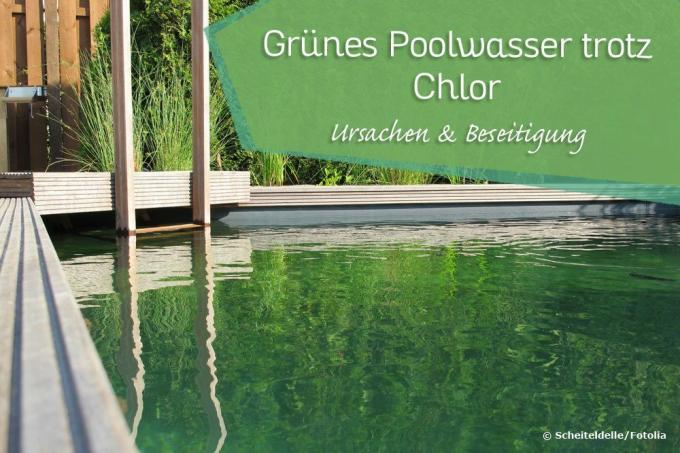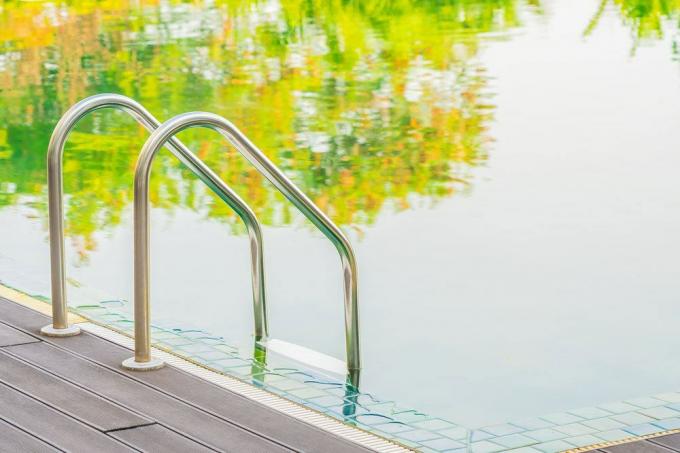
table of contents
- Why does pool water turn green?
- Eliminate green pool water
- Phase 1 - contain algae growth
- Phase 2 - Eliminate the cause
- Wrong PH value
- High dirt entrainment
- Water filtration disruptions
- Phase 3 - Establishing the water balance
Anyone who owns a pool cannot avoid having to deal with the technology and especially the water quality for long-term bathing fun. Despite sufficient chlorine and a controlled technology, it can still happen that the pool water turns green. What went wrong in this case and what promises to be a remedy is explained in the following in an easy-to-understand way.
Why does pool water turn green?
Actually one assumes that a pool is under Use of chlorine and if there is a filter system is not critical and the water quality is always in the "green" range with regular checks and readjustments. However, there are various aspects that can cause problems in a coherent system. The result is usually the formation of algae, which then leads to the undesirable green coloration of the water:
- Incorrect pH value, thereby promoting algae growth and reducing the effectiveness of chlorine
- High levels of dirt, resulting in an increased supply of nutrients for algae
- Disturbance or failure of the filter as a result of high levels of foreign matter and nutrients in the water
Attention: Pool water turning green is often associated with the appearance of algae. Of course, the association of aquatic life with the coloring is correct. However, algae are always found in small quantities in pool water. However, only when they multiply excessively do they lead to Water turbidity and finally - discoloration!
Eliminate green pool water
Once it has come to the point that the actually clear, inviting water of the pool has degenerated into a cloudy and unsavory green soup, the causes must be tackled in a targeted manner. It is worthwhile to proceed in several stages:
- Direct control of the algae to prevent further multiplication
- Eliminate the causes of the immense algae growth
- Adjustment of the water values for a functioning disinfection

You can find out how the individual steps are implemented in the following step-by-step explanations:
Phase 1 - contain algae growth
You can not get the real problems under control by combating the algae, you but prevents a further increase and thus an intensification of the green pool water simply and fast. The use of so-called algicides, i.e. agents specifically developed to kill algae, is ideal:
- Determine the pool volume, either already known, or calculated using length x width x height
- Determine the required amount of algicide from the pool volume and the manufacturer's instructions
- Add the agent to the pool water according to the manufacturer's instructions and observe the specified waiting time, if necessary activate circulation to improve distribution or set the water in motion manually
Phase 2 - Eliminate the cause
After the immediate multiplication of the unwanted pool dwellers has been prevented, one should subsequently it is imperative to eliminate the cause that enables the algae to grow at all to the extent encountered Has. To do this, of course, it is first necessary to determine the cause. For the sake of simplicity, research into the cause is dealt with directly with the respective remedy.
Wrong PH value
- Determination of the cause using a pH test set, pH test strips or laboratory test
- Establishing a target pH value (ideally between 7.0 and 7.4) and comparing the actual value with the target value
- Determination of the required lowering or raising of the pH value
- Selection of suitable preparations for pH adjustment via providers of pool supplies
- Depending on the selected preparation, dosage according to the manufacturer's instructions and the pool content already determined for algae control
- Adding the preparation to the pool water, as well as ensuring an even distribution
- Finally, another pH check as already described
Attention: In the further course of the algae control, the addition of chlorine and other activities can cause the pH value of the water to change again. It should therefore be checked again before the bathing operation is resumed to ensure that the water disinfection works properly due to the chlorine present!
High dirt entrainment
- Fishing off floating foreign matter using a pool net
- Removal of sunk dirt particles by activating the water circulation and using existing filter devices
- Removal of adhering dirt from the pool floor and walls using a pool brush

Note: In addition to the dirt particles brought in from the outside, the algae, which have now been killed, are of course also among the foreign substances to be removed. As a mostly firmly adhering coating on the pool surface, the dead algae represent an ideal biofilm and thus a breeding ground for future algae growth.
Water filtration disruptions
If there are problems with the pool's filter system, eliminating the cause is the most difficult. Depending on the type of system, very individual steps may be required. In general, however, this approach is effective in most cases:
- Checking the general function, usually recognizable by means of a control lamp or operating noise
- Failure to function: first check power supply, if necessary check existing fuse, open plug connections Check that it is firmly seated and check the ballast and cables for damage - do not forget the power supply at the house!
- General function detected: Check the output of filtered water
- If there is no water output, open the filter and check for foreign matter, either remove the filter and clean it, or replace the filter material
- Check the supply line to the filter for foreign bodies
- If the functionality still does not work, call in an expert technician
Attention: As a layperson, you should never open electrical or mechanical components of the filter system that are not intended for this. As a result, the components could be damaged and injuries could be caused. Intensive work on the filter system should therefore only be carried out by competent persons, such as the manufacturer's service technicians!
Phase 3 - Establishing the water balance
Once all active work to remove the algae infestation has been completed, restoring the desired water balance will help actively prevent renewed infestation. These steps may be necessary in particular if part or even all of the water in the pool has been replaced due to heavy pollution. This measure can be useful after severe algae infestation, as it still does so in spite of cleaning and filtration Clouding substances can remain in the water, which can only be completely removed with great effort. The essential steps for adjusting the water parameters are:
- Check the pH value as already described
- If there are deviations from the ideal value, readjust the pH value using a pH reducer or lifter
- Control of the chlorine content
- If the chlorine value is too low, add chlorine; if water is exchanged, shock chlorination makes sense
- at too high chlorine value If necessary, wait before going swimming, alternatively lower the chlorine content by adding fresh water

Note: In order to kill the existing algae, we have specifically used algaecides. To prevent a new infestation, however, these funds are not necessary. With proper disinfection, the chlorine dissolved in the water is usually able to keep the algae under control and prevent green pool water.


